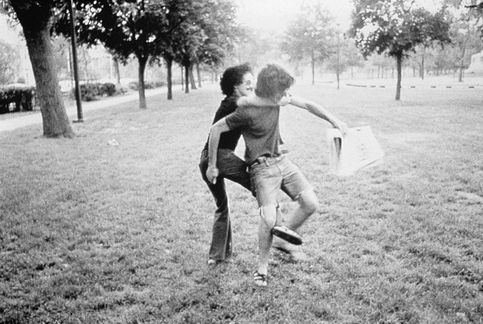The Mythic Being, Getting Back

Adrian Piper
The Mythic Being, Getting Back, 1975
Documentation of the performance 5 black-and-white photographs, vintage prints, silver gelatin on baryta paper 4 photographs 20.32 x 25.4 cm each, 1 photograph 25.4 x 20.32 cm, framed 38.7 x 29.8 cm each
GF0003327.00.0-2003
Artwork text
Notes on the Mythic Being I. A person frees himself from himself in the very act by which he makes himself an object for himself. — Jean-Paul Sartre, Being and Nothingness 1. Each month, I select a passage from the journal which I have been keeping for the last fourteen years. This is done on a systematic basis. The passage is called a ”mantra.” The visual image of the Mythic Being appears publicly on a monthly basis in the ”Village Voice” on the Gallery page. The mantra is reascribed to the personal history of the Mythic Being by appearing as the content of his thought in the thought balloon. During that month, the mantra and the autobiographical situation that provoked it become an object of meditation for me. I repeat it, reexperience it, examine and analyze it, infuse myself with it until I have wrung it of personal meaning and significance. It becomes an object for me to contemplate and simultaneously loses its status as an element in my own personality or subjecthood. As my subjecthood weakens, the meaning of the object thus weakens, and vice versa. The end result is that I am freer for having exhausted it as an important determinant in my life, while it simultaneously gains public status in the eyes of the many who apprehend it. The experience of the Mythic Being thus becomes part of the public history and is no longer a part of my own. 2. I began by dressing in the guise of the Mythic Being and appearing publicly several times during the month (reascription of my thoughts and history, sentence by sentence, to a masculine version of myself; myself in drag). I now consider shelving this aspect of the piece for fear that the Mythic Being will gradually acquire a personal autobiography of experiences and feelings as particular and localized — and limited — as my own. This was the misfortune of Rose Selavy. My behavior changes. I swagger, stride, lope, lower my eyebrows, raise my shoulders, sit with my legs wide apart on the subway, so as to accommodate my protruding genitalia. My sexual attention to women flows more freely, uninhibited by my fear of their rejection in case my feelings should show in my face; unencumbered by my usual feminine suspicions of them as ultimately hostile competitors for men. I follow them with my eyes on the street, fantasizing vivid scenes of lovemaking and intimacy. My sexual attraction to men is complicated and altered by my masculine appearance. I envision possibility of deep love relationships based on friendship, trust, camaraderie, masculine empathy; but I instinctively suppress expression of my sexual feeling for fear of alienating the comparatively tenuous feelings of kinship with men I now have. How might I be different if the history I chronicled in my journal had happened to a man? My adolescent preoccupations with men would have been infused with guilt; my conflicting feelings and behavior toward my girl friends would have been viewed with alarm by my parents; my stints as model and discotheque dancer would have schooled me in the subtle art of transvestitism; my drug experiences might have been more traumatic and conflict-ridden, perhaps more sexually than mystically oriented. Has this part of the piece taught me about myself, or about the Mythic Being? 3. The Mythic Being is, or may be: An unrealized but possible product of the particular history of events I in fact underwent, a necessary alternative to the limits of my sense of self; An abstract entity of mythic proportions, whose history is a matter of public knowledge and whose presence and thoughts are dispersed over the totality of individuals who apprehend him in the ”Voice;” A nonmaterial art object, unspecified with regard to time or place, the bearer of a finite number of properties, the number and quality of which are circumscribed by my own life, and acquired coextensively with my growth into a ”different” person; A product of my own self-consciousness, and unlike other pieces I have done in not being the generator of my self-consciousness; A therapeutic device for freeing me of the burden of my past, which haunts me, determines all my actions, increasingly habituates me to the limitations of my personality and physical appearance. 4. A conceptual problem: I find it difficult to figure out what this piece is really about, if it is really about anything, because it is not one in a series of similar pieces over which I can generalize. Because this is only one of its kind that I have worked on since last September, I have no way of finding out what it has in common with other such pieces (although I can say things about its relationship to everything I’ve done in the last few years), thus no way of knowing what directions it represents to me, nor what I intend by doing it. All my speculations about it thus seem inconclusive to me; I have the feeling that I will never be sure of what it is I’m really up to. (Adrian Piper)





